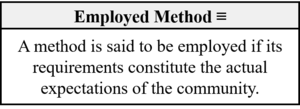Employed Method (Patton-Overgaard-Barseghyan-2017)
This is a definition of Employed Method that states "A method is said to be employed if its requirements constitute the actual expectations of the community."
This definition of Employed Method was formulated by Nicholas Overgaard, Hakob Barseghyan and Paul Patton in 2017.1
Contents
Scientonomic History
The major flaw of the previous definition of the term was that it defined method employment in terms of the indicators of method employment. The definition confused the actual phenomenon of method employment with scientonomic means of detecting method employment. This is unacceptable, since employed methods can, in principle, be detected in many different ways. For instance, the fact of a method’s employment can be detected by analyzing the record of transitions from one accepted theory to the next in a particular community at a particular time. Alternatively, we can try to infer the employed method of the time from our knowledge of the body of accepted theories using the third law. The previous definition of employed method equated method employment with one particular way of identifying method employment. According to the authors of the new definition:
"It is as though a type of subatomic particle were to be defined through the trace it leaves on a photographic plate, despite the fact that it can also be detected in other ways, such as with a bubble chamber or cloud chamber. Evidently, the fundamental attributes of a particle are one thing (i.e. mass, spin, electric charge, etc.), while the means that we currently use to detect the particle and its attributes is another. The two clearly don’t coincide because a particle can be detected using many different techniques (e.g. by photographic plate, bubble chamber, cloud chamber, etc.)."1p. 35
Similarly, the phenomenon of method employment should not be confused with the means of its identification. Thus, the previous definition of employed method was deficient and a new definition was needed.
Acceptance Record
| Community | Accepted From | Acceptance Indicators | Still Accepted | Accepted Until | Rejection Indicators |
|---|---|---|---|---|---|
| Scientonomy | 29 November 2017 | The definition became accepted as a result of the acceptance of the respective suggested modification. | No | 1 September 2019 | This definition of the term was rejected when the usage of the term as referring to an epistemic stance was deprecated after the acceptance of the term norm employment. |
Suggestions To Accept
Here are all the modifications where the acceptance of this definition has been suggested:
| Modification | Community | Date Suggested | Summary | Verdict | Verdict Rationale | Date Assessed |
|---|---|---|---|---|---|---|
| Sciento-2017-0004 | Scientonomy | 5 February 2017 | Accept the reformulation of the second law which explicitly links theory assessment outcomes with theory acceptance/unacceptance. To that end, accept three new definitions for theory assessment outcomes (satisfied, not satisfied, and inconclusive) as well as the new ontology of theory assessment outcomes, and accept the new definition of employed method. | Accepted | The new formulation of the law became accepted as a result of a communal consensus. It was noted by the commentators that the "modification provides a much improved formulation of the 2nd law".c1 It was noted that the new formulation "decouples the method from acceptance outcomes" and "is needed to avoid a contradiction for cases where assessment by the method is inconclusive, but the theory is accepted".c2 It was agreed that the new law eliminates two of the major flaws of the previous formulation. First, it clearly states the relations between different assessment outcomes and the actual theory acceptance/unacceptance. Second, it clearly forbids certain conceivable courses of events and, thus, doesn't sounds like a tautology.c3 | 29 November 2017 |
Question Answered
Employed Method (Patton-Overgaard-Barseghyan-2017) is an attempt to answer the following question: What is employed method? How should it be defined?
See Employed Method for more details.
Description
According to this definition of the term, employed method is nothing but the actual expectations of a certain community at a certain time. This is in tune with the actual scientonomic usage of the term. It is safe to say that this definition is tacitly used throughout Barseghyan's The Laws of Scientific Change. For instance, when he says that the method of intuition schooled by experience was employed by the community of Aristotelian-Medieval natural philosophers, he actually means that this community expected new theories to be intuitively true.2pp. 143-1451p. 35 When he says that the double-blind trial method is currently employed in drug testing, he means that "the community expects new drugs to be tested in double-blind trials".1p. 352pp. 134-142 Originally, this tacit definition of employed method has been repeatedly conflated with the official definition of the term given on page 54 of The Laws of Scientific Change.2pp. 54,144,145 However, a community’s expectations were not mentioned in Barseghyan's original definition of employed method.
This new definition of employed method as "expectations of the community" was suggested to fix this conflation.
Reasons
No reasons are indicated for this definition.
If a reason supporting this definition is missing, please add it here.
Questions About This Definition
There are no higher-order questions concerning this definition.
If a question about this definition is missing, please add it here.
References
- a b c d Patton, Paul; Overgaard, Nicholas and Barseghyan, Hakob. (2017) Reformulating the Second Law. Scientonomy 1, 29-39. Retrieved from https://www.scientojournal.com/index.php/scientonomy/article/view/27158.
- a b c Barseghyan, Hakob. (2015) The Laws of Scientific Change. Springer.
